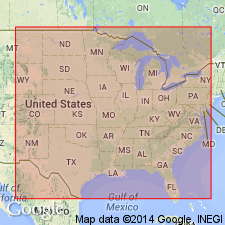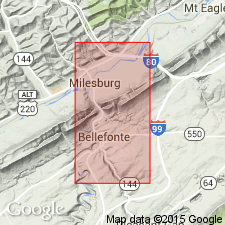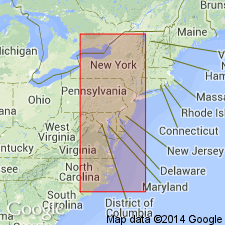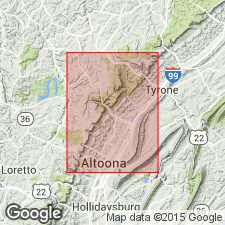
- Usage in publication:
-
- Axemann limestone*
- Modifications:
-
- Original reference
- Dominant lithology:
-
- Limestone
- AAPG geologic province:
-
- Appalachian basin
Summary:
Pg. 552, 653, 657, 674, pl. 27. Axeman[n] limestone. Thick and thin-bedded, nearly pure limestone, of dark color, frequently stained with iron oxide, and ranging from compact to distinctly crystalline. Thickness 158 feet. Underlies Bellefonte dolomite and overlies Nittany dolomite. Age is Early Ordovician.
Source: US geologic names lexicon (USGS Bull. 896, p. 97).

- Usage in publication:
-
- Axemann limestone*
- Modifications:
-
- Overview
- AAPG geologic province:
-
- Appalachian basin
Summary:
Axeman limestone of Beekmantown group. Recognized in Center [Centre] and Blair Counties, central Pennsylvania. Age is Early Ordovician. The limestone at Axeman, Center [Centre] County, is Stonehenge limestone, which underlies Nittany dolomite, but the limestone named Axemann crops out 1 mile east of Axemann. The Bellefonte, Axemann, Nittany, and Stonehenge compose Beekmantown group of central Pennsylvania.
Source: US geologic names lexicon (USGS Bull. 896, p. 97).

- Usage in publication:
-
- Axemann limestone*
- Modifications:
-
- Biostratigraphic dating
- AAPG geologic province:
-
- Appalachian basin
Summary:
Pg. 23. Axemann limestone of Beekmantown group. Fossiliferous pure upper Canadian limestone, 158 feet thick, at Bellefonte, [Centre County], Pennsylvania. Here it rests on about 500 feet of dolomite [Nittany] containing unquestionable Cotter fossils; succeeded by Bellefonte dolomite which extends upward, with thickness of 2,140 feet, to boundary between Canadian and Ordovician systems. Suggests term Nittany be abandoned.
Source: US geologic names lexicon (USGS Bull. 1200, p. 181).

- Usage in publication:
-
- Axemann limestone
- Modifications:
-
- Areal extent
- AAPG geologic province:
-
- Appalachian basin
Summary:
Pg. 1555, 1556 (fig. 19). Axemann limestone of Beekmantown group. Medium-bedded bluish limestone. Thickness 500 feet. Underlies Bellefonte dolomite; overlies Nittany dolomite, Beekmantown group. Age is Early Ordovician.
Source: US geologic names lexicon (USGS Bull. 1200, p. 181).

- Usage in publication:
-
- Axemann Formation
- Modifications:
-
- Areal extent
- AAPG geologic province:
-
- Appalachian basin
Summary:
Axemann extends only across Centre Co. and southwestward into Blair Co. Unit is predominantly limestone, possibly containing interbedded dolomite. It is represented in Blair Co. by just a few limestone beds, consisting of medium-dark or dark gray homogeneous, fine-grained calcisiltite and calcilutite. Lower contact with the Nittany Formation and the upper contact with the Bellefonte Formation are not exposed. Thickness is poorly estimated at 15+/-10 m. The best exposure is in the northeast corner of the Spruce Creek quad, on the north side of the Little Juniata River, 1.5 km northwest of Spruce Creek (40 deg 37'01" N, 78 deg 09'01" W). Unit underlies the low, rolling terrain in the center of Sinking Valley.
Source: GNU records (USGS DDS-6; Reston GNULEX).
- Usage in publication:
-
- Axemann Formation
- AAPG geologic province:
-
- Appalachian basin
Brezinski, D.K., Taylor, J.F., and Repetski, J.E., 2012, Sequential development of platform to off-platform facies of the great American carbonate bank in the central Appalachians; Chapter 15: American Association of Petroleum Geologists Memoir, 98, p. 383-420.
Summary:
Pg. 386 (fig. 2); see also T.M. Berg and others, Pennsylvania Geol. Survey Gen. Geol. Rpt., no. 75 (revised 1993). Axemann Formation of Beekmantown Group. Lies below Bellefonte Dolomite and above Nittany Dolomite, both of Beekmantown Group. Equivalent to middle parts of Rockdale Run and Epler Formations of Beekmantown Group. Extends from ACODUS DELTATUS-ONEOTODUS COSTATUS to OEPIKODUS COMMUNIS conodont zone; RANANASUS BREVICEPHALUS to PETIGURUS CULLISONI trilobite zone (see also Morgan, ch. 4, fig. 4 foldout, same vol.). Age is Early Ordovician (Ibexian; Arenig; Jeffersonian to Cassinian).
Source: Publication.
For more information, please contact Nancy Stamm, Geologic Names Committee Secretary.
Asterisk (*) indicates published by U.S. Geological Survey authors.
"No current usage" (†) implies that a name has been abandoned or has fallen into disuse. Former usage and, if known, replacement name given in parentheses ( ).
Slash (/) indicates name conflicts with nomenclatural guidelines (CSN, 1933; ACSN, 1961, 1970; NACSN, 1983, 2005, 2021). May be explained within brackets ([ ]).

